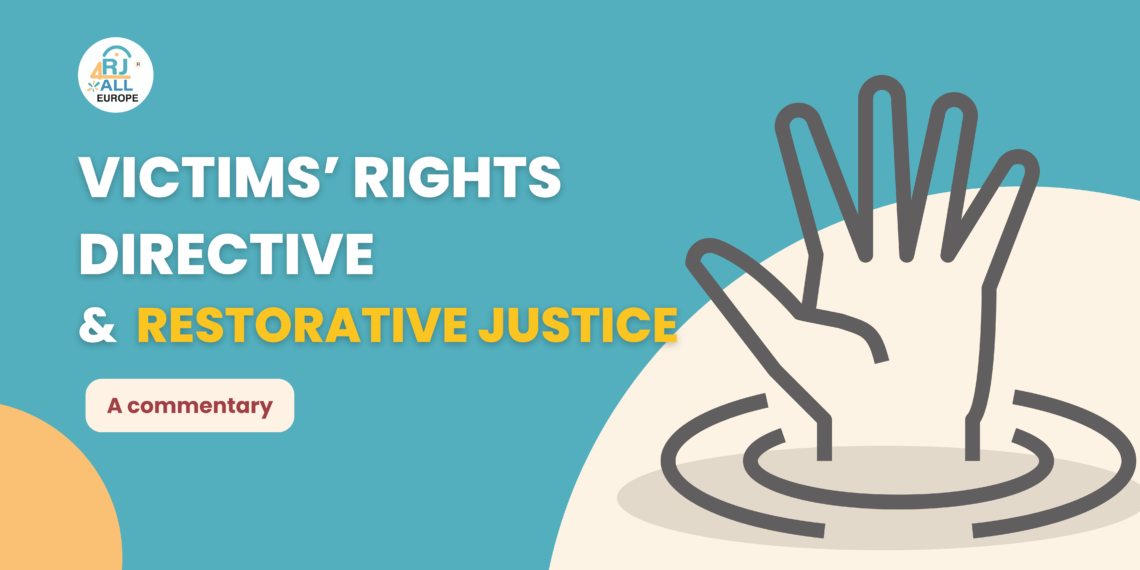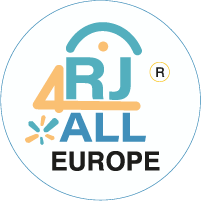
No matter what we believe or envision about the way harmed people are treated after a crime occurs, the reality of victims’ rights is still far away from full implementation. We cannot disregard the remarkable progress in Europe through numerous initiatives and relevant EU acts which are either mainstreaming victims’ rights or trying to protect particular categories of victims1 or areas of concern, like compensation or protection orders2. Undoubtedly, the Victims’ Rights Directive (Directive 2012/29/EU of the European Parliament and of the Council) [VRD], adopted on 25 October 2012, marked a milestone in victims’ rights by establishing minimum standards on the rights, support and protection of victims of crime and became the main EU horizontal instrument.
The 2012 Victims’ Rights Directive and Restorative Justice
The VRD formed the first ever legally binding European act that actively brought to the table the concept of restorative justice and to this end, it became a fundamental driving force for the implementation in the EU Member States.3 After all EU countries had received proper guidance on transposing the entire Directive into their national jurisdictions,4 the European Commission decided to dive into this main EU act for victims’ rights, assess the implementation process, and reflect on any progress.5 This was summarised in the 2020 Implementation Report.
Where does Restorative Justice stand after the VRD?
In relation to restorative justice, the 2020 Implementation Report brought troubles in the definitions opted for restorative justice avenues in national jurisdictions. The report shed light that most states that chose to welcome restorative justice into their legislation had done so without ultimately complying with the minimum safeguards articulated in Article 12 of the VRD. Furthermore, the referral mechanisms to restorative justice proved to be one of the most blurred and unstructured areas in most countries. But above all, the most problematic aspect remained that the VDR simply regulated the necessary minimum standards pertaining to the practice of restorative justice, while the adoption of national restorative justice services was left at the full discretion of each state.
Following the release of the 2020 implementation Report, in the same year, the European Union passed its first-ever EU Strategy on victims’ rights for 2020-2025, redirecting all efforts to meet victims’ needs. The EU Strategy was meant to be a very promising document for the EU and the future of restorative justice. It was hoped to form a very clear path towards restorative justice services. In fact, the document highlighted all the pitfalls and shortcomings of the conventional criminal justice system in terms of meeting victims’ needs. The strategy also explicitly discussed the much-debatable problem of secondary victimization, which is also acknowledged in Recital 53 of the VRD. As the problem is still evident everywhere and the system continues to retraumatize victims and leave their real needs unmet, the European Commission’s Strategy wished to put the “empowerment of victims” on the spotlight. They explicitly clarified that “Restorative justice is important in this regard”. From our point of view, this statement should have been made even clearer in the core of the Strategy (and not only as a feature in the footnotes). The strategy however still affirms that restorative justice can be envisaged as a way to empower victims of crime and re-confer them the chance to gain their lost power, become engaged in the proceedings to seek healing, and answers and seek a sense of justice. Additionally, both the Strategy but also the Directive have not put any barrier for certain categories of victims to access restorative justice services, but rather seem to applaud a crime and victim-symmetric approach, when the option of restorative justice is offered.
The Proposal’s shortcomings
Overall, this leaves us again with the problem of accessibility and empowerment of restorative justice, which is something we expected to be addressed through the proposed revision of the Directive 2012/29/EU (hereinafter the “Proposal”). On the 12th of July 2023, the Proposal for a DIRECTIVE OF THE EUROPEAN PARLIAMENT AND OF THE COUNCIL amending Directive 2012/29/EU became public before its adoption by the European Parliament and the Council. We were expecting to see advancements around restorative justice, with the scope to achieve the full potential of restorative justice services but were quickly disillusioned. While the five main objectives for revision on access to information, improved support and protection, improved participation in criminal proceedings and facilitated access to compensation, are absolutely embraced, the proposal falls short of addressing and removing some essential obstacles emerging from the VRD for more effective accessibility for victims to restorative justice. And therefore, restorative justice continues to slip through the cracks of non-orchestrated and incomplete efforts, managed by the lack of a holistic repositioning of restorative justice in Europe. 6
Empowerment of Restorative Justice
Having delved into the most relevant legally binding documents in the field of RJ, we can securely address certain points in which the Proposal could be more radical in raising existing obstacles. Beyond simply focusing on safeguarding/protecting restorative justice, the new proposal could have placed more burden on empowering RJ. 7The VRD seems to be highly oriented towards the safeguards that need to be in place when and if restorative justice is offered as a potential avenue after a crime. Article 12 of the VRD, which is the only article fully dedicated to restorative justice, sets out the right of victims to have certain minimum conditions and safeguards when getting involved in restorative justice services. However, there is no obligation for Member States to introduce restorative justice in their national jurisdictions and have it as a widely accessible service for victims at all stages of the criminal justice process and for all types of crime. Therefore, restorative justice remains disempowered, weakened and left in the shallow end of victims’ rights protection.
There is no doubt that the restorative justice process should be built on all the minimum standards and safeguards. But this stand-alone article in the VDR, which comes unaccompanied by the beneficial side of restorative justice, left us with something “weak”. 10 years later, the “Proposal” was the perfect opportunity to bring a better balance between safeguarding and empowering restorative justice, highlighting its potential for all involved stakeholders, and mainly victims (Biffi, 2016, p. 14).
Restorative Justice as a generally available avenue
A way to empower restorative justice is undoubtedly to make it a generally available service for victims at all stages of the criminal justice process and for all types of crime in all member states – assuming also that those services on offer are of good quality. Back in 2012, we were not expecting the Directive to oblige the full transposition of restorative justice into all national law. But today, 10 years later, the proposal should have paved the way to a more accessible practice, that all victims could opt for, if they wanted, after being fully aware by the relevant referring bodies and organisations encountering them. This is corroborated by the explicit ambition to head towards a more victim-oriented approach and the fact that we now have much more evidence on the beneficial results of restorative justice.
This victims’ right, of course, comes along with a provision that would enhance the already existing (Article 4 par. 1(j)) right to be informed about the available restorative justice services, securing better quality of information, from more relevant bodies, and through more stages throughout the process.
Additionally, with the intense dialogue existing in the academia around the appropriateness of restorative justice for victims of more severe crimes (i.e sexual violence, domestic violence), the new Proposal could have paved the way to resolve this dilemma, based on the extensive empirical research and the hundreds of voices of victims of these crimes stating the benefits to their healing process (given of course that all the safeguards are respected and are in place).
Finally, further on the blurred boundaries of the Proposal’s victim-centered approach, the Proposal falls short of avoiding the strict terms of “victim” and “offender”, missing the chance to put in the spotlight all those involved in harm to equally deal with the aftermath of a series of actions.8
Training and cross-discipline cooperation
Lastly, a seamless and holistic regulation on restorative justice would have required a section on the much-needed training and cooperation of all the involved parties and referring bodies, including the judiciary, the police, the victim support services, the probation, prisons etc. Yet, there is a remarkable gap in knowledge and awareness about the values and principles of restorative justice. And the gaps get even bigger when talking about practice, steps and necessary safeguards, and sharing evidence of how this process can turn out to be life-changing and justice-oriented.
Concluding remarks
The revision of the VRD was long coming after valuable evaluations pinpointed its shortcomings and ways forward. As stated in the Proposal, “the minimum standards on what constitutes child-friendly and victim-centred justice have risen in the past 10 years”. Given this “rise” and with the increased usage and evidence behind restorative justice, we would have expected it to be better placed within the current victim-centred justice context of the revised Directive, which seeks further minimum standards to ensure the effectiveness of the Victims’ Rights Directive. According to a survey from the European Forum for Restorative Justice in September 2021, there are no particular problems in safeguarding restorative justice and securing victims. This implies that we are safe in moving a step forward and unleashing the full potential of restorative justice.
In a nutshell, the amendment had multiple ways to make significant advancements for restorative justice but failed at it. We remain therefore in critical need for an empowerment of restorative justice through law, where restorative justice is widely accessible to all victims regardless of the stage or the crime-type.
The article was drafted by Sofia Sideridou, Project Officer, and Lorenzo Izzi, Volunteer from RJ4All Europe. With a mission to advance our communities, bring justice and support all those harmed, RJ4All Europe remains active in restoring and empowering European Societies. In RJ4All Europe, we keep alive the European dialogue pertaining to criminal justice, victims’ rights and needs and we advocate for the necessary advancements based on the values of restorative justice.
- Directive 2011/36/EU of the European Parliament and of the Council of 5 April 2011 on preventing and combating trafficking in human beings and protecting its victims ↩︎
- Council Directive 2004/80/EC of 29 April 2004 relating to compensation to crime victims (the ‘Compensation Directive’); Directive 2011/99/EU of the European Parliament and of the Council of 13 December 2011 on the European protection order and Regulation (EU) No 606/2013 of the European Parliament and of the Council of 12 June 2013 on mutual recognition of protection measures in civil matters. ↩︎
- Gavrielides, T. (2015). “The Victims’ Directive and What Victims Want from Restorative Justice”, Victims and Offenders Journal, Vol: 10. Issue 2. pages 1-22. DOI 10.1080/15564886.2014.982778. ↩︎
- Guidance document from the DG justice related to the transposition and implementation of Directive 2012/29/EU of the European Parliament and of the Council of 25 October 2012 establishing minimum standards on the rights, support and protection of victims of crime, and replacing Council Framework Decision 2001/220/JHA ↩︎
- Report from the European Commission to the parliament and the council on the implementation of Directive 2012/29/EU of the European Parliament and of the Council of 25 October 2012 establishing minimum standards on the rights, support and protection of victims of crime, and replacing Council Framework Decision 2001/220/JHA ↩︎
- Gavrielides, T. (2016). “Repositioning Restorative Justice in Europe: The Victims’ Directive”, Victims & Offenders Vol. 11, Iss. 1, pp. 71-86. ↩︎
- Gavrielides, T. (2019) Safeguarding and Empowering Crime Victims: Training manual: Restorative justice and the Victims’ Directive, London: RJ4All Publications. ISBN: 978-1-911634-09-6. DOI: 10.13140/RG.2.2.10019.12327 ↩︎
- Gavrielides, T. (2017). “Collapsing the labels “victim” and “offender” in the Victims’ Directive & the paradox of Restorative Justice”. International Journal of Restorative Justice, Volume 5, Special Issue 3: Reimagining victims and restorative justice: the European Union, Canada and beyond, p. 368-381. ↩︎









